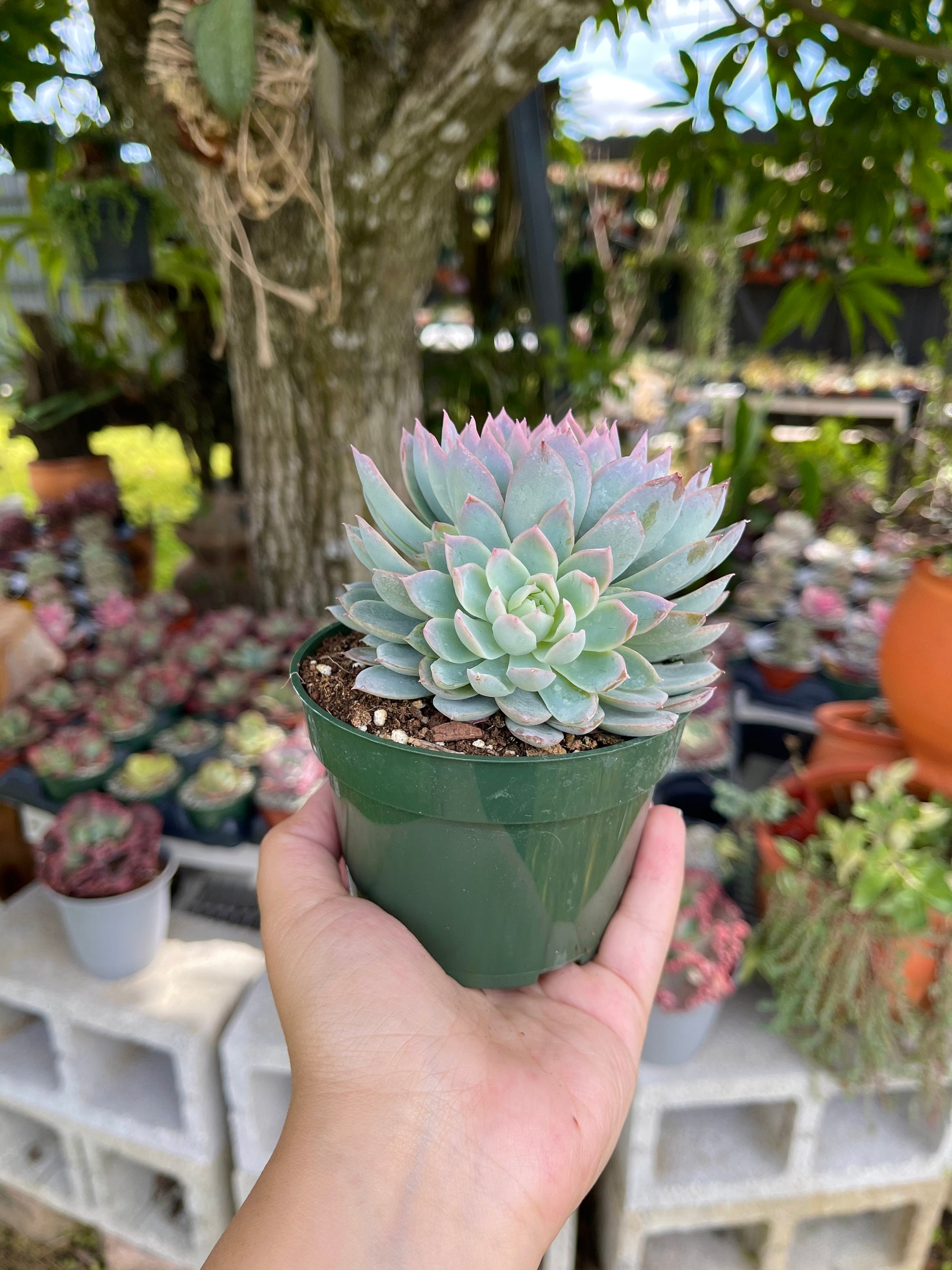This succulent is a rapid grower with leaves that point up, mimicking a lotus flower. When provided with the right amount of stress, the tips of the leaves take on a pink hue. The plant has a tendency to spread out in clusters of up to 20 rosettes. In the Springtime, you may be able to spot white or grey-green flowers on the plant.
Table of Contents
Care and Propagation Information
Echeveria ‘Violet Queen’ is an ideal choice for xeriscaped landscapes, offering a stunning display of color throughout the year. Additionally, its blossoms are a great source of nourishment for hummingbirds.
Watering
Echeveria ‘Violet Queen’ should have its soil watered using the “soak and dry” method, where the soil is allowed to dry out completely before being re-watered. This type of succulent has typical watering needs.
Where to Plant
If you live in an area that experiences temperatures below 20° F (-6.7° C), it’s best to grow the Violet Queen succulent in a pot that can be brought indoors. It will thrive in either full or partial sunlight.
Suggestion: Place the plant in a spot of your garden that gets 6 hours of direct sunlight a day, or if planting indoors, position it near a window that receives plenty of sunlight, such as one facing south (for those living in the Northern Hemisphere).
How to Propagate Echeveria ‘Violet Queen’
Echeveria ‘Violet Queen’ can be grown from cuttings taken from the existing plant, either from its leaves or its offsets.
Offsets
Violet Queen will create little rosette offshoots, which can be detached from the stem with a clean, sharp cutting tool such as scissors or a knife. Allow the cuttings to air dry for 24 to 48 hours before placing them on soil that allows water to drain away.
Leaves
To successfully propagate ‘Violet Queen’ from leaves, gently remove a leaf from the mother plant, making sure that no part of the leaf remains on the stem. Doing so will ensure a higher rate of success.
Let the leaf sit for a few days until the cut end has sealed, then put it in soil that drains well. Water it only once the soil is completely dry.
Care and Propagation Information
General Care for Echeveria ‘Violet Queen’
Watering
Echeveria ‘Violet Queen’ should have its soil watered using the “soak and dry” method, where the soil is allowed to dry out completely before being re-watered. This type of succulent has typical watering needs.
Where to Plant
If you live in an area that experiences temperatures below 20° F (-6.7° C), it’s best to grow the Violet Queen succulent in a pot that can be brought indoors. It will thrive in either full or partial sunlight.
Suggestion: Place the plant in a spot of your garden that gets 6 hours of direct sunlight a day, or if planting indoors, position it near a window that receives plenty of sunlight, such as one facing south (for those living in the Northern Hemisphere).
How to Propagate Echeveria ‘Violet Queen’
Echeveria ‘Violet Queen’ can be grown from cuttings taken from the existing plant, either from its leaves or its offsets.
Offsets
Violet Queen will create little rosette offshoots, which can be detached from the stem with a clean, sharp cutting tool such as scissors or a knife. Allow the cuttings to air dry for 24 to 48 hours before placing them on soil that allows water to drain away.
Leaves
To successfully propagate ‘Violet Queen’ from leaves, gently remove a leaf from the mother plant, making sure that no part of the leaf remains on the stem. Doing so will ensure a higher rate of success.
Let the leaf sit for a few days until the cut end has sealed, then put it in soil that drains well. Water it only once the soil is completely dry.
FAQ
How do you take care of a violet queen succulent?
Echeveria ‘Violet Queen’ should be watered using the “soak and dry” method, allowing the soil to completely dry out between waterings. This is consistent with the watering needs of most succulents.
How big does a violet queen succulent get?
Under ideal conditions, Echeveria Violet Queen can reach a size of around 15cm in width and 10cm in height. If the plant is left to form clumps, it can become bigger in size.
How big do Echeveria succulents get?
They are native to the dry, rocky areas of Mexico, Central, and South America and come in a variety of sizes, shapes, and colors. The most recognizable species of echeveria have rosette-shaped leaves that come in shades of green, gray, or pink.
Why is my Echeveria growing tall?
Etiolation can occur when a succulent does not receive enough sunlight, which can cause it to become thin and leggy, as well as change in color and shape. This is especially common in indoor succulents, as they may not get enough direct sunlight, but it can happen to any type of succulent.
How big do Echeveria violet queen get?
Five inches in height.



